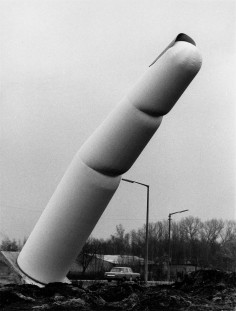Haus-Rucker-Co
하우스-루커-코
是由豪斯拉克科
14-metre inflatable index finger
source: spatialagencynet
Haus-Rucker-Co were a Viennese group founded in 1967 by Laurids Ortner, Günther Zamp Kelp and Klaus Pinter, later joined by Manfred Ortner. Their work explored the performative potential of architecture through installations and happenings using pneumatic structures or prosthetic devices that altered perceptions of space. Such concerns fit with the utopian architectural experiments of the 1960s by groups such as Superstudio, Archizoom, Ant Farm and Coop Himmelblau. Alongside these groups, Haus-Rucker-Co were exploring on the one hand, the potential of architecture as a form of critique, and on the other the possibility of creating designs for technically mediated experimental environments and utopian cities.
Taking their cue from the Situationist’s ideas of play as a means of engaging citizens, Haus-Rucker-Co created performances where viewers became participants and could influence their own environments, becoming more than just passive onlookers. These installations were usually made from pneumatic structures such as Oase No. 7 (1972), which was created for Documenta 5 in Kassel, Germany. An inflatable structure emerged from the façade of an existing building creating a space for relaxation and play, of which contemporary echoes can be found in the ‘urban reserves’ of Santiago Cirugeda. The different versions of the Mind Expander series (1967-69), consisted of various helmets that could alter the perceptions of those wearing them, for example the ‘Fly Head’ disoriented the sight and hearing of the wearer to create an entirely new apprehension of reality; it also produced one of their most memorable images.
Haus-Rucker-Co’s installations served as a critique of the confined spaces of bourgeois life creating temporary, disposable architecture, whilst their prosthetic devices were designed to enhance sensory experience and highlight the taken-for-granted nature of our senses, seen also in the contemporaneous work of the Brazilian artist Lygia Clark. Contemporary versions of such work can be found in the pneumatic structures favoured by Raumlabor and Exyzt.
.
.
.
.
.
.
.
source: mundochica
Haus-Rucker-Co fue un grupo vienés fundado en el año 1967 por Laurids Ortner,Günter Zampo Kelp y Pinter Klaus.Su trabajo explora el potencial performativo de la arquitectura a través de instalaciones y eventos utilizando estructuras ó dispositivos protésicos en un logrado intento de alterar la realidad y la percepción de espacio.
La palabra performativo encuentra aquí el concepto para la que fue creada.Performativo se refiere a que “por el mismo hecho de ser nombrada se convierte en accción” ó al arte de transformar:La capacidad de transformar la sociedad no sólo mediante la palabra sino que las palabras se transformen en acciones siendo éstas capaces de transformar el mundo en un lugar pacífico,de paz y dignidad humanas.
En el año 1960 los experimentos utópicos arquitectónicos se basan en éste concepto,en especial los de Haus-Rucker-Co quiénes juntos a otros grupos artísticos exploraban el poder diseñar objetos que sirvieran para éste cometido de ciudades extraordinarias.
Involucrar al individuo de manera directa con la filosofía de su arquitectura y para lo que estaba diselada era prioritario para Haus-Rucker-Co.Un espectador pasivo ante una obra no puede de alguna manera llegar a sentir cómo lo haría una persona que toma parte de ella,por lo que podríamos decir que sus creaciones son de alguna manera interactivas y la persona es necesaria para llegar a entender profundamente cada diseño creado influyendo así en su entorno.
Las distintas versiones de “Mind Expander”(1967-1969) se componía de varios cascos capaces de alterar las percepciones de cualquiera que los usase.En esa época era cotidiano el tema de la percepción cómo algo necesario para explorar la mente y conocerse uno mismo.
El casco llamado “Fly-Head” era capaz de desorientar la vista y el oído alterando la realidad de la persona y fué éste en concreto el que tuvo más éxito en el público ya que las fotografías no dejan indiferente a nadie.
Las instalaciones de Haus-Rucker-Co se convirtieron en una crítica a los espacios cerrados y a la vida burguesa creando una arquitectura temporal y desechable siendo la base e inspiración de otros diseñadores más contemporáneos.
.
.
.
.
.
.
source: jtknwordpress
Treffen sich ein Architekt, ein Flüchtling, ein Sandmann, ein Pflanzer, ein Wettermacher, ein Sonnenlenker, ein Terminator, ein Widerstandskämpfer und ein Kapitän in Zeiten des Klimawandels. Jeder weiß am besten, wie er aus der Krise flüchtet und wählt seine eigene Strategie.
Der Architekt träumt von einer Seifenblase, der Flüchtling wartet auf die schwimmende Insel, der Sandmann bewacht die Kapselstadt mitten in der Wüste, der Pflanzer findet seinen Schutz im Garten Eden, der Wettermacher kämpft gegen die Wolken, der Sonnenlenker zeigt sich als Spezialist im Geo-Engineering, während der Terminator mit einer Zeitkapsel in die Zukunft reisen kann, der Widerstandskämpfer gegen die uniformen Gesetze der Kapselwelt ankämpft und der Kapitän von seinem Schiff Ausschau nach Flüchtlingsbooten hält – neun Szenen mit neun Protagonisten. Neun mögliche Handlungsweisen, die sich ergänzen oder auch ausschließen.
Verknüpft mit dem Glossar, das übrigens mehr als doppelt so viele Seiten wie die Portraits hat, erzählen Kurzgeschichten in einer Mischung aus Phantasie, Referenzen und O-Tönen eine mögliche Geschichte von Utopia. Anstelle eines Katalogs begleitet also dieses Suhrkamp-Heftchen die gleichnamige Ausstellung. Deshalb will die Textcollage vor allem eins: erklären und aufklären.
„Klimakapseln.Überlebensbedingungen in der Katastrophe” gibt einen guten Überblick über Projekte, in deren Rahmen sich Künstler, Regisseure und Architekten in den letzten Jahrzehnten mit dem Thema Klima befasst haben. Ergänzend zur Ausstellung eine gute Lektüre, die man aber wohl kaum im Park lesen wird – dafür ist sie dann doch etwas zu nüchtern. (jk)
.
.
.
.
.
.
source: papelesdecroquisblogspot
Se trata de uno de los proyectos que la compañía Rucker-co realizó dentro de su programa “vanille future”, que hace una referencia al futuro que ellos imaginan.
.
.
.
.
.
.
source: envpeople
图示设计被称为“飞行头”,这个头盔由Haus-Rucker-Co设计于1968年,作为一种环境转换器,内里包含了视听过滤器,可以分散周围声音,并且将佩戴者的视野分解成面状。


